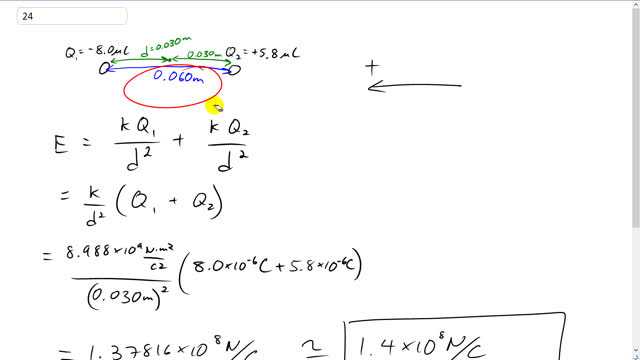
Determine the magnitude and direction of the electric field at a point midway between a and a charge 6.0 cm apart. Assume no other charges are nearby.

In order to watch this solution you need to have a subscription.
This is Giancoli Answers with Mr. Dychko. We have a charge here of negative eight microcoulombs, another charge of positive 5.8 microcoulombs. These charges are separated by .060 meters. That's 6.0 centimeters written in meters. We'll take left to be the positive direction today, and we need to find the electric field at this point midway between the charges. So this point is .03 meters from the left charge and it's .03 meters from the right charge. Total distance divided by two. So we have electric field as kQ one over d squared plus kQ two over d squared, d being the distance from this point of interest, midway between them and one of the charges. No need for a subscript on the d because it's the same distance between this point and either of the charges. I'm taking care of negative signs here and both of these are gonna be to the left. And we're gonna take left to be positive, and so there are no negative signs and both of these electric fields will be directed to the left because this positive charge here exerts an electric field at this point away from it because it would repel a positive test charge placed there. This charge will result in an electric field also to the left because a positive test charge placed here would be attracted to this Q one. And so both of them are in the positive direction being to the left. We can factor out the k over d squared and then it gets multiplied by Q one plus Q two. Since I've took some care of the negative signs here, that means we plug in positive eight microcoulombs here, and then plus 5.8 times 10 to the minus 6 Coulombs for this charge, Q two. And then multiplied by Coulomb's constant, 8.988 times 10 to the nine Newton meters squared per Coulomb square, divided by the distance from this point of interest to either of the charges, 0.03 meters squared. This gives 1.4 times 10 to the eight Newtons per Coulomb, and it's away from the positive charge.
Why do we just assume the midway point of interest is a positive test charge? What if it is just a point at which a neutron resides? I know we couldn't tell what that is in real life because we use positive test charges, but how do we know that the question is asking us to assume that the point is positive? How do we know that the question is not simply testing our knowledge of attractive and repelling charges in which the electric field would point to the right from the positive charge and to the left from the negative charge? I hope this makes sense.
Would it also be acceptable to look at the problem like this... Q1= -8 x 10^-6 C, Q2= +5.8 x 10^-6 C and they are interacting with eachother at point p (midway point) which we shall assume is neutral in and of itself except for the interaction of these two field charges. We will take right to be the pos direction. The force from Q2 is to the left and is pulling/ attracting Q1. This would cause a vector to the right (+). Q1 is pulling Q2 to the left, this would cause a vector to the left (-). I then add KQ1/r^2 -(8.998 x 10^9)(-8x10^-6)/ .03^2 plus KQ2/r^2 (8.988 x 10)(5.8x10^-6)/.03^2. This also equals 1.4 x 10^8 N/C. Is this acceptable or did I just get lucky?